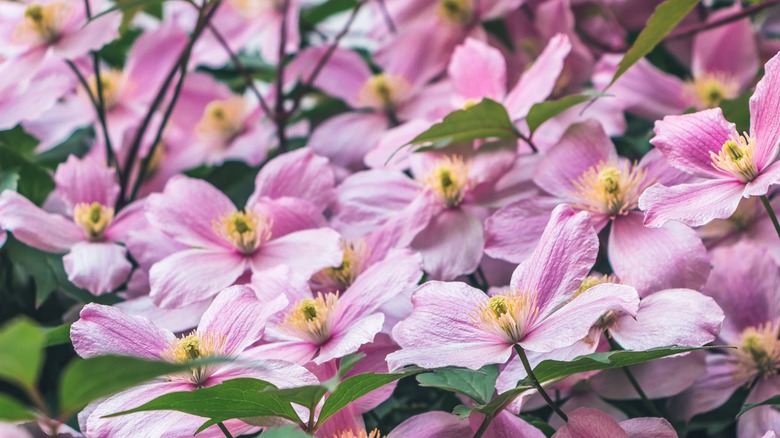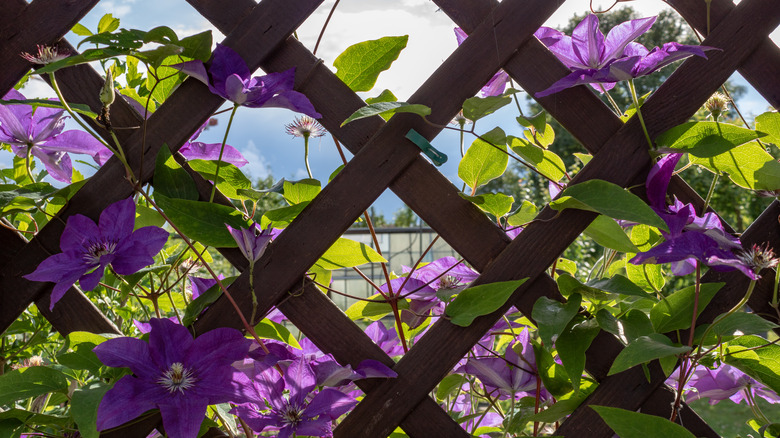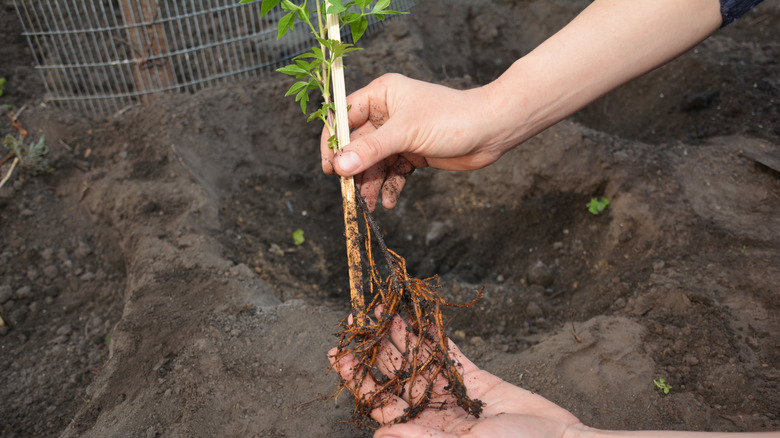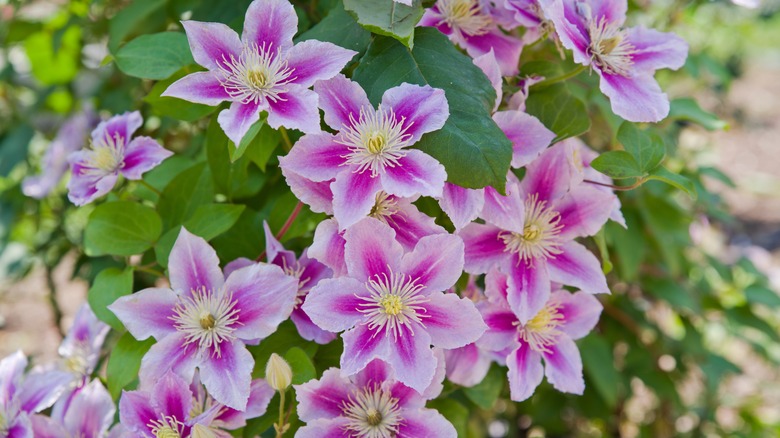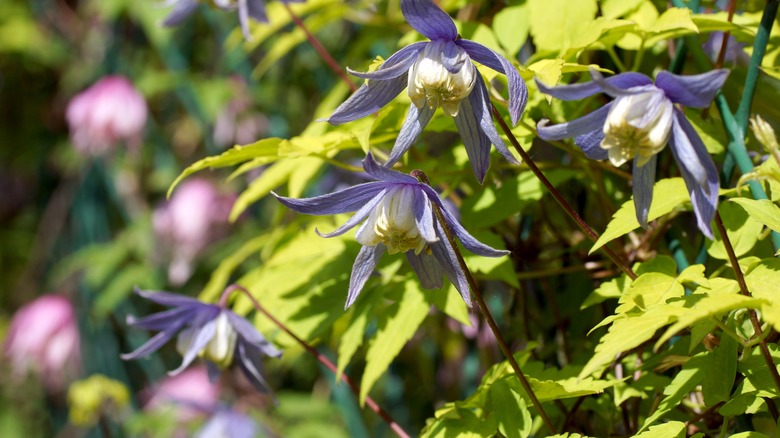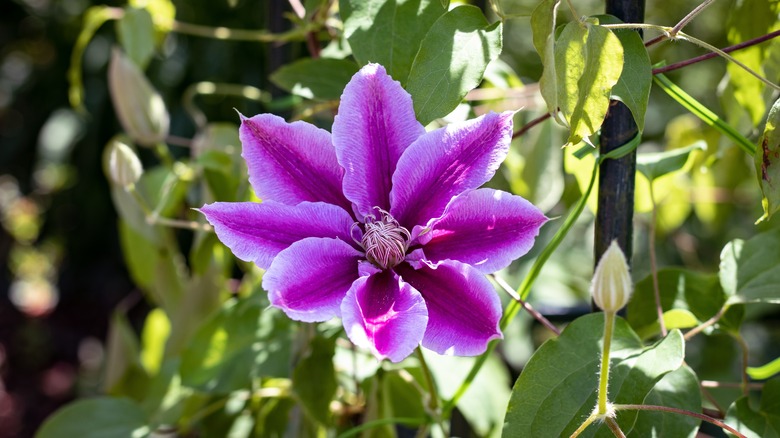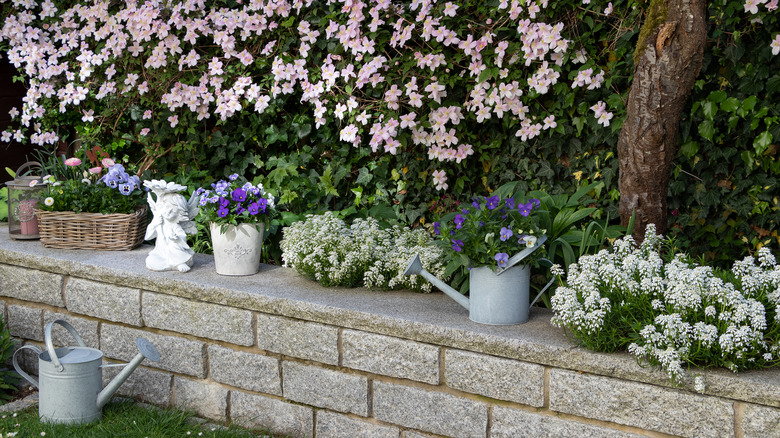Clematis: Everything You Should Know Before Planting
Clematis, colloquially known as Queen of the Climbers, Virgin's Bower, and Leather Flower, is an ornamental flowering vine in the Ranunculaceae or buttercup family. It has taken hold throughout the world, particularly in Asia, Europe, and North America. The name clematis is derived from klema, a Greek word denoting a climbing vine. Botanist Carl Linnaeus first classified the genus in 1753, but it was known in England as early as 1549. Clematis was cultivated in Japan in the 1600s, according to Gardener's Path.
There are as many as 400 clematis species and unlimited cultivars. Clematis plants are profusely flowered, and a single one can produce in excess of 100 blooms per season, Clemson Home & Garden Information Center says. Common colors include white, pink, red, blue, lavender, and purple (and occasionally yellow). The flowers can be anywhere from 4 to 10 inches in diameter.
Flower shapes are diverse as well, with styles including tubes, urns, stars, bells, pinwheels, plates, or even tulip-shaped. They can be flat or open, and many varieties are fragrant. Clematis can range from a 2-foot shrub to vines soaring at least 30 feet, as does the c. montana species, per Gardeners Supply Company. In nature, clematis is found mostly in temperate regions, primarily in USDA zones 3 to 9.
How to use clematis in the garden
There are several ways to exploit the many differences in clematis varieties, growing styles, and sizes. Doing so can provide an unusual spark to your backyard, as per Garden Design, because planting a mix of types prolongs the area's blooming period. You can decorate corners in the yard with smaller clematis plants housed in pots. A garden's entrance or house's entryway are also attractive places for one. You can also adorn a bare wall with a clematis mounted on a trellis. Should you desire ground cover, herbaceous clematis shrubs are a good choice.
If your garden features a pergola, arbor, fence, or trellis, why not complement it with a sturdy, steadily climbing clematis? If the garden is small or crowded, you can compensate by emphasizing the vertical space: Planting a tall species will work wonders. Clematis plants and flowers can be an effective combination. Hydrangeas, peonies, certain roses, and some lilies work well with the vines or shrubs. Longfield Gardens suggests combining clematis with other varieties, including Ramona, Blue Light, Niobe, and Multi-Blue. Clematis vines will also crawl up a magnolia tree to dramatic effect.
How to grow clematis
Clematis is a climber and needs something to wrap itself around. Commercial specimens generally share their pot with a stake for support. According to Gardener's Path, clematis is not difficult to cultivate, but a home grower's uncertainty regarding pruning can pose problems. Annual pruning is recommended for all species to stimulate vigorous flowering, but early-blooming types, large flowering varieties, and late bloomers have different pruning schedules and need to be treated differently as well.
Garden Design abides by several general rules: No matter the type, wait until it flowers before pruning. Also, no pruning in the fall and stems with developing buds should be left alone. Another suggestion is to wait until mid-spring before working on the previous year's growth. Fortunately, per The Impatient Gardener, a clematis is relatively impervious to faulty pruning: You may end up with sparse or deformed blooms, but the plant should survive.
The preferred propagation method is to use stem cuttings, a much faster process than germinating from seeds. Using a long vine with multiple sets of leaves is best. Plant stems into a pot with moist soil and place in bright, indirect light. Roots should appear four to six weeks later, ready for the new plant to be transplanted.
How to care for clematis
A sunny spot is best for clematis vines, and six hours of sun is optimal for blooming. A caveat: too strong direct sunlight can cause some flower colors to fade. Another caveat: shield clematis from strong wind. Soil should be kept cool and moist for root health, but plants should not sit in water. The motto for successful clematis growers: face in the sun, feet in the shade. Clematis prefer neutral soil or soil that is slightly alkaline, so, you can neutralize a too-acidic one periodically. Surrounding clematis with a ground covering plant or mulch is a great idea to keep it away from the area where vines rise from the soil.
A healthy clematis plant requires only basic care, with an emphasis on weekly watering. Irrigation frequency can be increased during periods of dryness; around 1 inch or gallon of water is the recommended amount because a vibrant clematis is a well-fed one. Gardener's Supply Company recommends applying a water-soluble fertilizer at the beginning of spring. Follow this up with one or two reapplications during the growing season. A slow grower in its initial stages, clematis can then increase in size by as much as 8 feet in subsequent seasons, depending on the variety.
Varieties of clematis
Clematis can be climbing, woody vines, or non-climbing herbaceous shrubs. They are perennials, but some are evergreens. As a result, there is a significant variance in sizes, flower colors, and bloom times. Some popular cultivars you might run across include Jackmanii, General Sikorski, Henryi, and Comtesse de Bouchard, per Gardener's Supply Company. A selection of clematis varieties includes the following, as identified by Clemson Home & Garden Information Center:
- Alpine clematis (c. alpina): A smaller variety, it attains 6 to 8 feet and has diminutive flowers. It is a spring bloomer.
- Anemone clematis (c. montana): This giant is considered one of the easiest clematis types to grow.
- Armand's clematis (c. armandii): Reaching an impressive 30 feet or higher, this evergreen variety also blooms in the spring. It produces white flowers massed in clusters redolent of vanilla.
- Clematis praecox: This species is a good choice for a ground cover.
- Downy clematis (c. macropetala): A mid-sized variety (15 feet), its bell-shaped bluish flowers arrive in May and June. Downy clematis favors cooler and shadier conditions more than other varieties.
- Florida clematis (c. florida): This one is best suited for warmer areas and features colorful and fancy flowers.
- Sweet autumn clematis (c. terniflora): An invasive species capable of generating thousands of white flowers, it re-seeds vigorously. Gardeners are advised not to plant them, per The Impatient Gardener.
Is clematis toxic?
The ASPCA identifies clematis as being toxic to dogs, cats, and equines. However, animals may balk at consuming it due to an exceptionally bitter taste, making it relatively deer-resistant, although rabbits and mice have been known to nibble. In addition, clematis plants contain a glycoside that may cause drooling and gastric upset in animals. Garden Design suggests wearing gloves when handling it to prevent possible skin irritation. Conversely, traditional Chinese medicine has recognized some health benefits of clematis' ingredients for centuries. Herbal practitioners recommend it to treat gout, rheumatism, and various skin ailments.
Especially in its first year, the plant is susceptible to clematis wilt, a fungal condition in which it withers, its stems and foliage blacken, and the afflicted specimen dies. Water the bottom of the plant, not the foliage, to prevent wilt. Insufficient air circulation can result in mildew. Also, be on the lookout for scales, earwigs, aphids, mites, whiteflies, and damage from slugs. As a bonus, though, your clematis may be a magnet for butterflies and hummingbirds.
How to repot clematis
Clematis is a plant that prefers not to be moved. If you are to repot one, have a plan in mind for setting up an adequate support system in its new home (Longfield Gardens). The plant will require something to climb on from the beginning. Twine, wire, dowels, or fishing lines are good choices, per Gardener's Supply Company. It may take a while for it to become accustomed to its new surroundings.
A rule to follow when repotting is to use a deeper pot than the original one. Ensure there is enough space to provide adequate airflow. You can prep the new hole with granular organic fertilizer or compost, and can also add bone meal for root health. Loam soil that is loose and drains well is best. Gardener's Path recommends immersing the rootball in water for 15 minutes before repotting; a quart- or gallon-sized container will be adequate. Finally, ensure not to damage the fragile roots, crown, or new vines.
